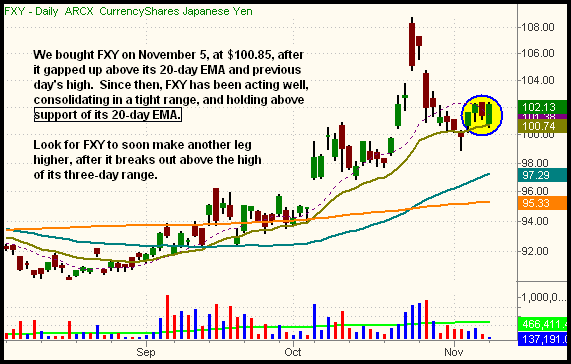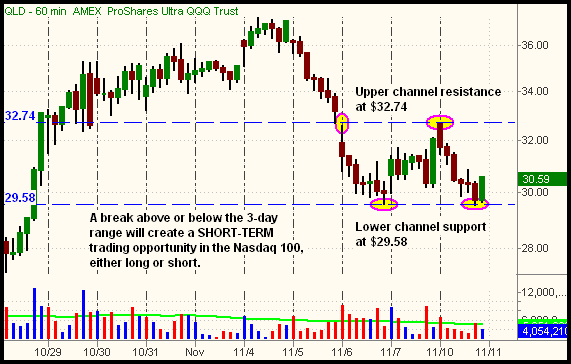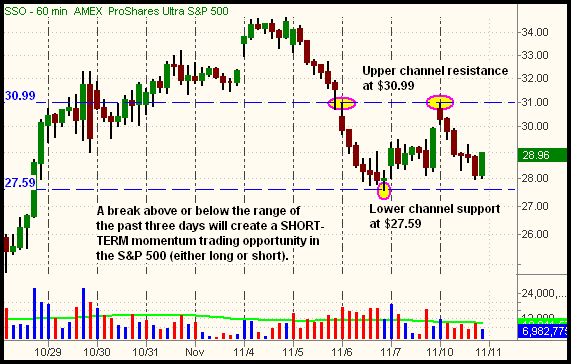Right now, focusing on a shorter-term time horizon, as well as trading with reduced position size, is a much safer bet than taking intermediate-term trades with full size in an indecisive market.
Giving back a substantial chunk of last Friday's gains, stocks got off to an uninspiring start to the week. Bullish momentum from the previous day's strong close caused the major indices to open substantially higher, but traders quickly sold into strength of the initial gains. Stocks subsequently trended lower throughout the day. The Dow Jones Industrial Average lost 0.8%, the S&P 500 1.3%, and the Nasdaq Composite 1.9%. Small and mid-caps showed notable relative weakness; both the Russell 2000 and S&P Midcap 400 indices fell 2.5%. A bounce in the final thirty minutes of trading lifted the main stock market indexes off their worst levels of the day, but they still closed near the bottom quarter of their intraday ranges.
One positive of yesterday's session is that turnover continued to recede. Total volume in the NYSE was 7% lighter than the previous day's level, while volume in the Nasdaq declined 11%. Trading in both exchanges limped in at its lowest levels in months, hinting that market participants are taking a "wait and see" approach in the current environment. Still, the losses on decreasing volume enabled the S&P 500 and Nasdaq Composite to dodge the label of an institutional "distribution day." Market internals were negative, but not by a drastic margin. Declining volume in the NYSE exceeded advancing volume by a ratio of just over 2 to 1. The Nasdaq adv/dec volume ratio was negative by approximately 3 to 1.
Presently, we have four open ETF positions in our model portfolio: iShares Japanese Yen (FXY), iShares Corporate Bond (LQD), Gold Double Long (DGP), and iShares Nasdaq Biotech (IBB). Of these, FXY is showing the most bullish chart pattern and upside potential. Below is an updated look at the daily chart of FXY: 
In late October, FXY broke out to a fresh all-time high, then pulled back to support of its 20-day EMA (the beige line). We subsequently bought FXY on November 5, at $100.85, after it gapped up above the previous day's high and 20-day EMA. Since then, FXY has been building a nice base of support, right above its 20-day EMA. Yesterday, it closed at the high of its short-term range, increasing the odds of FXY making another leg higher in the near future. A rally above the three-day high of $102.36 should trigger bullish momentum in FXY.
Recapping our other open positions, both LQD and DGP are showing unrealized gains as well. LQD pulled back only slightly after running into its 50-day MA, and we're sticking with it due to our profit buffer on the position. DGP has been choppy and hasn't done much, though gold is starting to show signs of life again. We remain long IBB, which is showing an unrealized loss of less than a point, because the biotech sector is showing relative strength to the broad market. Overall, our current portfolio is relatively well hedged, and has a low correlation to the broad market direction.
In yesterday's newsletter, we showed how the S&P 500, as well as other indices, have just been oscillating in a wide, sideways range for the past month. On a technical level, yesterday's action did not change that. But looking at the shorter-term hourly charts of the major indices, we see that tighter ranges have developed over the past three days. A break above the highs of those three-day ranges, or below the lows of those ranges, may present us with short-term momentum trading opportunities that would likely carry stocks to either the highs or lows of their intermediate-term trading ranges of the past month. To illustrate this, take a look at the hourly charts of two popular ETF proxies for the broad market: Ultra Nasdaq 100 ProShares (QLD) and Ultra S&P 500 ProShares (SSO). Moving averages have been removed so you can more easily see the sideways channels of support and resistance: 
Yesterday, QLD gapped up to open at the high of November 6, then trended down to bounce off support of its November 6 low in the final hour of trading. November 7 was an "inside day," meaning its intraday range was completely contained within the previous day's trading range. With this three-day pattern, the Nasdaq 100 can simply be bought on a breakout above yesterday's high, or sold short on a breakdown below yesterday's low. On the long side, buying QQQQ would be a simple ETF play, but QLD provides more "bang for the buck" because it's leveraged to move at twice the percentage move of the underlying index. On the short side, rather than selling short QQQQ or QLD, one can buy the inversely correlated Short Nasdaq 100 ProShares (PSQ) or the leveraged UltraShort Nasdaq 100 ProShares (QID). Buying the inversely correlated Short and UltraShort ETFs has the added benefit of enabling bearish positions in non-marginable cash accounts, such as an IRA. Next, check out SSO: 
SSO, which is leveraged and tracks the S&P 500, showed slight relative strength to QLD (the Nasdaq 100) yesterday, as it never touched the November 6 low. Nevertheless, SSO could just as easily show relative weakness to QLD today. On the long side, the S&P 500 can be traded through SPY or SSO. For the inversely correlated S&P 500, consider buying SH (Short ProShares) or SDS (UltraShort ProShares). In addition to the S&P 500 and Nasdaq 100, keep an eye on the Dow Jones Industrial Average, Russell 2000, and S&P Midcap 400 indices as well. All the broad-based indexes have similar short-term trading ranges, so it will simply be a matter of which index shows bullish or bearish divergence by being the first to break out of its three-day range. For a list of corresponding ETFs for the broad-based indexes, download our free Morpheus ETF Roundup.
If any of the major indices break out of their three-day ranges and you decide to enter a short-term trade in the same direction, be sure to keep a tight stop to protect against a failed breakout. When the stock market is stuck in an overall choppy, sideways range, failed short-term breakouts are relatively common. Keeping a protective stop not far beyond the breakout or breakdown levels will enable you to quickly close the position for a minimal loss if there is a lack of follow-through in either direction. As for profit taking on an upside breakout, consider selling into strength of the mid-October highs. On a downside breakdown, look to cover short positions on a test of the October lows. Regular subscribers to The Wagner Daily will receive detailed stop and target prices if we enter any of these plays.
Though we normally prefer to take trades of a longer time horizon (2 to 5 weeks), we must take what the market gives us. Right now, focusing on a shorter-term time horizon, as well as trading with reduced position size, is a much safer bet than taking intermediate-term trades with full size in an indecisive market. When volatility eventually starts to settle down for more than a few days at a time, and intermediate-term trends become more well established (in either direction), we'll become more aggressive with new plays, and those of the usual time horizon. Until then, we'll focus on staying hedged on both sides of the market, and also trading ETFs with a low direct correlation to the broad market.
Open ETF positions:
Long - FXY, LQD, IBB, DGP
Short - (none)
Deron Wagner is the Founder and Head Trader of both Morpheus Capital LP, a U.S. hedge fund, and Morpheus Trading Group, a trader education firm launched in 2001 that provides daily technical analysis of the leading ETFs and stocks. For a free trial to the full version of The Wagner Daily or to learn about Wagner's other services, visit MorpheusTrading.com or send an e-mail to deron@morpheustrading.com.